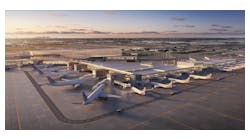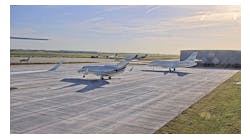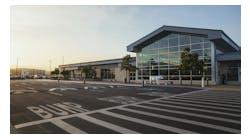Cargo Revolution
High-performance equipment and IT drives Air Canada Cargo's giant automated handling facility at the Pearson International Airport, writes Carroll McCormick
By Michelle Garetson/p>
By Carroll McCormick
September 2002
From a second-story vantage, an enormous matrix of green storage racks holding 1,900 bright yellow freight roll carts almost disappears as the eye follows it to a distant wall. Hidden behind another wall is a second storage area, large enough to swallow 650 unit loading devices (ULD) on their way to and from aircraft bellies. Guided by a computer-controlled Inventory Control System (ICS) that tracks the location of all the facility's freight with way bills and bar codes, a fleet of automated vehicles store and retrieve loose freight, ULDs and pallets while their human colleagues build up and break down containers, serve customers and fill in the gaps in transport, like running containers to the passenger terminal apron and unloading cookie sheets from roller trucks.
Air Canada began planning the automated facility several years ago when the Greater Toronto Airport Authority's expansion plans called for demolishing its old cargo building.
"We came to an agreement to build our [new] facility smack in the middle of the infield," says Claude Morin, Air Canada's Vice President - Cargo. "We have a world class facility."
Air Canada Cargo moved into the facility in February, 2002 and switched from manual to automatic control in July.
"We took into account Air Canada's growth over the next 10 years," says Project Manager Mike Roy. After acquiring Canadian Airlines in 2000, Air Canada modified the original design to accommodate the extra staff and cargo. As currently configured, it has a 300,000 tonne/year throughput capacity. There is room, however, to double the number of storage racks and roll carts to boost the capacity to a half-million tonnes annually.
Muratec (Murata Machinery Limited) and cdg, now owned by Logan, manufactured the equipment for the physical distribution system. Katlyn International Inc. provided the project management and the IT solutions (the computer control systems).
The combination of Muratec and Katlyn's technology was superior for the Air Canada facility, according to Roy. Too, Katlyn is a local company in Kitchener/Waterloo, Ontario.
"We knew we would get premier support from them," says Roy. Katlyn has worked on other large facilities; e.g., the Japan Airlines facility at New York's JFK Airport. Katlyn also has the service contracts for the facility and a 24/7 presence.
"The automated terminal allows us as management to determine what is going to happen in the building, when we want it to happen," explains Lise-Marie Turpin, General Manager, Cargo Operations - North America. "We are really controlling the pace [at which] we want the work done and what work should be done first."
Statistics and Logistics
The facility is 200 metres north of the air traffic control tower in the middle of the airport infield, on a huge swath of land bounded on all sides by runways. Authorised vehicles move cargo from the facility to the passenger aprons via a four-lane, 598-metre tunnel under Runway 15L/33R. Cargo trucks and other customers access the facility, fenced off from the rest of the infield, via a public road at the southwest corner of the airport.
The facility's long axis is oriented east-west. An interior wall along the long axis separates the ULD pallet/storage area in the rear, with its north-side exit to aircraft, from the front area of the facility, which contains everything else except the live animal annex. Three, rail-mounted Elevated Transfer Vehicles (ETV) automatically move ULDs and pallets to and from the storage racks.
The specifications required that the ETVs floor speed be at least 100 metres/minute. Transfer speed was less important as reaction time to a placed order.
Quick Processing
"Once a command is given, there shouldn't be a delay of more than 1or 2 seconds for the command to be downloaded to the unit. You want your commands to be continuous," explains Roy. The ETV vertical speed reaches a maximum 20 metres/minute.
In the front area, from east to west, is a dangerous goods room and dangerous goods agent office, a narrow, front-to-back Canada Post processing area designed to quickly feed mail through the building, a large open export area where trucks deliver loose freight through any of 19 import doors and where staff do some build up/breakdown work.
There are four import and four export build-up/breakdown pits with three-metre lowerable workstations and one import and one export each build-up/breakdown pits with 6.1-metre lowerable workstations.
Personnel on the export side receive cargo, sort and store it as loose freight in roll carts — one airway bill per cart — by destination and manually push them into any of ten centrally-located vertical conveyors - freight elevators, actually. They move the roll carts to and from the second-story-to-roof, 1900-position storage area, called the automated storage and retrieval system (AS/RS). The vertical conveyors deliver and collect rollboxes from a Robotrain-X, a conveyance system that travels around the perimeter of the AS/RS. Robotrain-X in turn delivers and accepts roll cars from four stacker cranes that store and retrieve roll boxes from that matrix of green storage racks. The stacker cranes reach a maximum vertical speed of 20 metres/minute. When tested, the AS/RS exceeded the design specifications of retrieving a minimum of 200 roll boxes an hour from the system.
Roll (Cart) Call
When it is time to assemble a flight, an operator instructs the automated system
to retrieve all the roll carts for Flight 123 from the AS/RS. Assembled containers
are automatically stored in the ULD/pallet storage area till they are called
down and run to the aircraft.
In the center of the front area is a cooler, a warmer, a high-value area and storage space for oversize freight.
"A small package handling system increases productivity," says Trish Millar-Ellis, Manager, Customer Service - the Americas & South Pacific. "To get freight from the back to the counter in the old [building] you had to send someone. You could lose someone for 20 minutes. There were forklifts going everywhere."
Now parcels up to 32 kilograms are moved automatically from the front counter or a carousel inside to a storage area for later assembly for a flight, or retrieved for clients.
At the west end of the facility is the equipment that handles palletised cargo. The customer service area is accessed through a south side entrance. To the west of it are 22 import doors and a rail-mounted airside transfer vehicle for servicing roller trucks.
ULDs brought from the planes are briefly parked in the ULD/pallet storage area, then retrieved and broken down in the front area. The bar codes are used to enter the freight into the system and the freight is stored in the AS/RS. When a driver comes to pick up freight, he needs only to present his way bill to a station attendant, who keys the way bill number in the system, which automatically retrieves the freight.
Gateway to North America
"We want [the facility] to become a gateway to North America and a connecting hub for our entire network. We will be able to move freight from the United Kingdom to Pearson to the United States better now than before. We will be able to handle volume we couldn't handle before and make it more attractive to the freight forwarders who are currently trucking freight to U.S. gateways," explains Turpin.
"We will be in a really good position to become much more aggressive selling the U.S. as a final destination," adds Morin.
Air Canada Cargo Worldwide
Air Canada Cargo, an autonomous business
unit within Air Canada, moves 700 tonnes of freight a day through its
Pearson facility, all of it in passenger aircraft. It self-handles its
Canadian operations, partly because of the infrastructure that is part
of the airline's legacy as a Crown corporation before becoming a shareholder-owned
corporation in 1989."By far our main operation is in Toronto. We
have well over 500 people working there," says Claude Morin, Air
Canada's Vice President - Cargo. Second in size is Vancouver, where the
airline's cargo activity more than doubled after absorbing Canadian Airline's
operations in 2000. "We have 9 or 10 flights a day to Asia, and on
a busy day in we are looking at over 400 tonnes of freight going through
our Vancouver facility," says Morin. "Third in size is Montreal
and after that you have 4 or 5 stations; e.g., Calgary, Winnipeg, Halifax,
that are the same size. In Vancouver we handle a couple of other carriers,
but that's about it - a key reason is a lack of sufficient space. In Toronto
that might change. If we have space capacity then it would be conceivable
to go after third party handling contracts."
Air Canada Cargo self-handles about 100 tonnes
of freight a day in Chicago. Because the airline flies only narrow bodies
from this and several other U.S. airports, Morin explains, "We containerise
it and then we hire trucks and put them on the road from Chicago [and
other border cities] to Toronto. The freight arrives already palletised
and all we do is a quick connection from Toronto to the rest of the world."
Air Canada Cargo self-handles at eight or
nine smaller stations, including Miami, Los Angeles, LaGuardia and San
Francisco, but does no cargo ground handling for other U.S. airlines.
In secondary cities where Air Canada flies narrow bodies, it farms out
the ground handling for its small cargo volumes.
Star Alliance partners handle some of Air
Canada Cargo's freight in the U.S. United Airlines handles its freight
in 15 states and at its big cargo operation in Hawaii. Lufthansa does
the work in a couple of other U.S. stations. "In cargo, we do compete
head on for certain routes. It is very much more a passenger-driven alliance
but we do some things on the cargo side, like between Montreal and Germany
… we [code share] and also share cargo capacity with Lufthansa. In
Houston, they have a very large operation. We are involved in the Houston
to Canada market and we don't compete. They do our ground handling and
there is never an issue of business potentially switching. That works
well," says Morin.
In Asia, Air Canada Cargo hires third parties,
but in Europe it has self-handles in Frankfurt, Paris and London. "We
have four or five other carriers we handle in London," says Morin,
"but it is really the exception."












